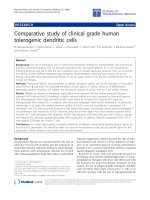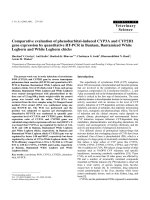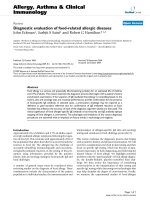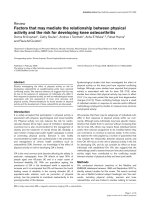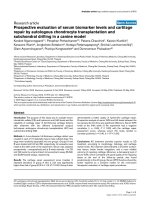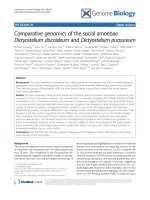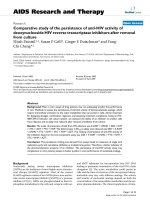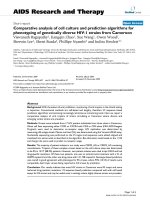Báo cáo y học: " Comparative evaluation of INNO-LiPA HBV assay, direct DNA sequencing and subtractive PCR-RFLP for genotyping of clinical HBV isolates" pot
Bạn đang xem bản rút gọn của tài liệu. Xem và tải ngay bản đầy đủ của tài liệu tại đây (407.31 KB, 5 trang )
Ali et al. Virology Journal 2010, 7:111
/>Open Access
SHORT REPORT
© 2010 Ali et al; licensee BioMed Central Ltd. This is an Open Access article distributed under the terms of the Creative Commons Attri-
bution License ( which permits unrestricted use, distribution, and reproduction in any
medium, provided the original work is properly cited.
Short report
Comparative evaluation of INNO-LiPA HBV assay,
direct DNA sequencing and subtractive PCR-RFLP
for genotyping of clinical HBV isolates
Maisa M Ali*
1,4
, Fuad Hasan
2,3,4
, Suhail Ahmad
1,4
and Widad Al-Nakib
1,4
Abstract
Genotypes (A to H) of hepatitis B virus (HBV) influence liver disease progression and response to antiviral therapy in
HBV-infected patients. Several methods have been developed for rapid genotyping of HBV strains. However, some of
these methods may not be suitable for developing countries. The performance of INNO-LiPA HBV Genotyping assay
(LiPA), direct DNA sequencing and subtractive PCR-RFLP of genotype-specific HBV genome regions were evaluated for
accurately determining the HBV genotypes by analyzing sera (n = 80) samples from chronic HBV patients. Both, LiPA
and DNA sequencing identified 63, 4 and 13 HBV strains as belonging to genotype D, genotype A and mixed genotype
A and D, respectively. On the contrary, the PCR-RFLP-based method correctly identified all 4 genotype A but only 56 of
63 genotype D strains. Seven genotype D strains yielded indeterminate results. DNA sequence comparisons showed
that a single nucleotide change in the target region generated an additional restriction site for Nla IV that
compromised the accuracy of this method. Furthermore, all the mixed genotype A and D strains were identified only as
genotype A strains. The data show that the PCR-RFLP-based method incorrectly identified some genotype D strains
and failed to identify mixed genotype infections while LiPA and DNA sequencing yielded accurate results.
Findings
Eight distinct genotypes (A to H) of hepatitis B virus
(HBV) have been identified and their occurrence exhibits
distinct preferences for ethnic origin of the patient and/or
geographic regions of the world [1,2]. Recent studies have
shown that HBV genotypes influence liver disease pro-
gression, selection of mutants and response to antiviral
therapy in acute and chronic HBV infections [3-5]. Con-
sidering the importance of determining the HBV geno-
type, several methods have been developed for
genotyping of HBV strains [6]. A PCR-RFLP-based
method that involves successive digestion of amplicon
with a battery of restriction enzymes to discriminate the
individual genotypes is most suitable for developing
countries. However, there is very limited data on its per-
formance in different countries/geographical settings
[7,8]. A commercially available reverse hybridization-
based line probe assay (INNO LiPA HBV Genotyping
assay, LiPA) is easy to perform and is also suitable for
detecting mixed genotype infections [9]. Despite these
advantages, the test is fairly expensive for resource-poor
countries. Direct DNA sequencing of PCR generated
amplicons corresponding to genotype-specific regions of
HBV genome also yields accurate genotype assignments
and is the method of choice for patients infected with
recombinant genotypes [9,10]. However, DNA sequenc-
ing is still considered as technically demanding, time con-
suming and costly in most of the developing countries.
This study was carried out to evaluate the performance of
three (LiPA, direct DNA sequencing and subtractive
PCR-RFLP) genotyping methods to determine the
method most suitable for routine use in a developing
country. The comparative performance of the three
methods was tested by using 80 consecutive HBV-DNA
positive serum samples obtained from chronic HBV
patients. The study was approved by the Committee for
the Protection of Human Subjects in Research, Faculty of
Medicine, Kuwait University. The HBV DNA was isolated
* Correspondence:
1
Department of Microbiology, Faculty of Medicine, Health Sciences Center,
Kuwait University, Kuwait
Full list of author information is available at the end of the article
Ali et al. Virology Journal 2010, 7:111
/>Page 2 of 5
from blood samples by using High Pure Template Prepa-
ration Kit (Roche Applied Science, Germany) according
to the kit instructions. The final pellet was resuspended
in 100 μl of pre-heated elution buffer and 10 μl was used
as a template for HBV DNA amplification. The LiPA kits
were obtained from Innogenetics (Belgium) and were
used according to the instructions supplied with the kit.
Briefly, the HBV DNA was amplified by nested PCR, the
amplicons were hybridized to genotype-specific probes
impregnated on membrane strips and the hybrids were
detected with chromogenic substrates. The LiPA results
were interpreted as instructed by the kit's manufacturer.
The genotype-specific segment of the HBV polymerase
gene was amplified and sequenced for DNA sequence-
based determination of specific HBV genotypes exactly as
described previously [10]. The subtractive PCR-RFLP-
based genotyping was performed by semi-nested PCR
amplification of a 485 bp fragment which was succes-
sively digested with 5 restriction enzymes (in separate
tubes) to identify genotype-specific sequences exactly as
described earlier [8]. For isolates giving aberrant results,
the amplicons were cloned in pGEM-T Easy plasmid as
described previously [11]. In each case, the plasmid DNA
was isolated from 10 independent clones of Escherichia
coli by a modified alkaline lysis procedure [12] and
sequenced by using quick start cycle DNA sequencing kit
(Beckman-Coulter). The DNA sequencing was per-
formed as described in detail previously [13,14]. The
LiPA identified 63 and four HBV strains as belonging to
genotype D and genotype A, respectively. Thirteen HBV
strains yielded amplicons that hybridized to probe prim-
ers specific for both, genotype A and genotype D, and
were thus identified as mixed genotype A and D strains.
The DNA sequencing data of genotype-specific region of
HBV polymerase gene correlated completely with the
genotype assignment obtained with LiPA for all the 80
strains. The results are consistent with earlier reports
showing the ability of the LiPA to detect mixed genotype
infections [9,15,16]. The comparative analyses of DNA
sequence data for all genotype D strains in Kuwait (data
from 10 selected isolates are shown in Figure 1) identified
a unique signature of AA dinucleotide at position 204 and
205 in the HBV polymerase gene. This signature
sequence is not only absent in representative genotype D
Figure 1 Alignment of nucleotide sequences of the HBPol gene product of HBV genotype D. A-to-T nucleotide substitution occurred at nt 204
in all HBV Kuwaiti isolates (KWT1-16). These substitutions represent unique signature sites for local HBV genotype D isolates (shaded). Representative
sequences of genotype D are shown (X59795
-ITALY, AJ344116-FRANCE, AY161157-INDIA, AB033559-PAPUA, AB078032-JAPAN, AY090453-SWEDEN,
AY741796
-IRAN, AB126581-RUSSIA, AB104712-EGYPT and AY721605-TURKEY).
KWT1 AACAGTTATATGGATGATGTGGTATTGGGGGCCAAGTCTGTACAGCATCTTGAGTCCCTT 264
KWT2 AA
KWT3 AA
KWT4 AA
KWT5 AA
KWT6 AA
KWT7 AA
KWT8 AA
KWT9 AA
KWT10 AA
KWT11 AA
KWT12 AA
KWT13 AA
X59795 TT
KWT14 AA
AJ344116 TT
AY161157 TT A A
KWT15 AA
AB033559 TT
KWT16 AA
AB078032 TT
AY090453 TT
AY741796 TT G G
AB126581 TT
AB104712 TT C G
AY721605 TT TC
Ali et al. Virology Journal 2010, 7:111
/>Page 3 of 5
strains isolated in Italy, France, Russian Federation, Swe-
den, India, Japan and Papua New Guinea [GenBank:
X59795
, AJ344116, AB126581, AY090453, AY161157,
AB078032
and AB033559; respectively] but also from
several Middle Eastern countries such as Iran, Egypt and
Turkey [17-19] (Figure 1). Since the genotype-specific
region of the HBV polymerase gene overlaps with the
surface antigen of the HBV (HBsAg), the sequencing data
can also be used to deduce the "a" determinant (amino
acids 124-147) of the S-gene specifying all the subtypes
[20]. Based on these analyses, three genotype D strains
displayed unusual amino acid substitutions. Two isolates
shared the amino acid pattern Arg
122
, Pro
127
and Ser
140
specifying ayw subtype with unique amino acid substitu-
tion involving residue 134 (Ile
134
or Asn
134
). The remain-
ing strain contained unique amino acid substitution at
codon 127 (Asn
127
). Furthermore, all the mixed genotype
A and D strains were untypeable, as expected. The sub-
tractive PCR-RFLP-based assay showed that none of the
strains belonged to genotype C, B, E or F. Following Nla
IV digestion, the 220 bp fragment characteristic for geno-
type A was observed with 17 HBV strains. Four of these
strains were identified as belonging to genotype A by
LiPA or DNA sequencing while the remaining 13 strains
were identified as mixed genotype A and D strains by the
other two genotyping methods. The data showed that the
Figure 2 Alignment of nucleotide sequences of the S-gene product. Representative sequence of genotypes A (X75669) and D (X65259) are
shown at the bottom of the raw. Inherent recognition sites of Nla IV in genotype D are shaded. T-to-C nucleotide substitution occurred at nt 291 (box)
in KWT-43 (local HBV isolate). These substitutions resulted in generation of a new recognition site of Nla IV (motif: GGNNCC).
KWT-43 CCGCAGAGTCTAGACTCGTGGTGGACTTCTCTCAATTTTCTAGGGGGAACCACCGTGTGT 300
X65259 T
X75669 T-A
KWT-43 CTTGGCCAAAATTCGCAGTCCCCAACCTCCAATCACTCACCAACCTCTTGTCCTCCAACT 360
X65259
X75669 C T-
KWT-43 TGTCCTGGTTATCGCTGGACGTGTCTGCGGCGTTTTATCATCTTCCTCTTCATCCTGCTG 420
X65259 T
X75669 T A
KWT-43 CTATGCCTCATCTTCTTGTTGGTTCTTCTGGACTATCAAGGTATGTTGCCCGCTTGTCCT 480
X65259 T
X75669 A T-G T
KWT-43 CTAATTCCAGGATCTTCAACAACCAGCACGGGACCATGCAGAACCTGCACGACTCCTGCT 540
X65259
X75669 A C T C
KWT-43 CAAGGAACCTCTATGTATCCCTCCTGTTGCTGTACCAAACCTTCGGACGGAAATTGCACC 600
X65259
X75669 C-A T A A A
KWT-43 TGTATTCCCATCCCATCATCTTGGGCTTTCGGAAAATTCCTATGGGAGTGGGCCTCAGCC 660
X65259
X75669 C C A T-
KWT-43 CGTTTCTCCTGGCTCAGTTTACTAGTGCCATTTGTTCAGTGGTTCGTAGGGCTTTCCCCC 720
X65259
X75669
Ali et al. Virology Journal 2010, 7:111
/>Page 4 of 5
PCR-RFLP-based method detected Genotype A status of
all HBV strains whether due to monoinfection with Gen-
otype A (n = 4) or due to mixed Genotype A and D infec-
tion (n = 13). Only 56 of the remaining 63 strains yielded
a 186 bp fragment characteristic for genotype D following
restriction digestion with Nla IV while the remaining
seven strains yielded atypical RFLP patterns (a ~220 bp
fragment was present in addition to the expected 186 bp
fragment) (data not shown). The 485 bp fragment from
all the seven isolates was, therefore, cloned in pGEM-T
Easy plasmid and 10 independent recombinant plasmids
for each HBV strain were sequenced. The DNA sequenc-
ing data showed that all the seven strains contained a T to
C nucleotide substitution at nucleotide position 291 that
generated a new recognition site of Nla IV within the
larger (265 bp) fragment that is ordinarily released fol-
lowing Nla IV digestion of 485 bp amplicon from geno-
type D strains (Figure 2). Thus, the presence of an
additional restriction site for Nla IV, resulting in further
digestion of 265 bp fragment into 41 bp and 224 bp frag-
ments, yielded aberrant results by PCR-RFLP-based
method. These findings are similar to an earlier report
from Uzbekistan. The PCR-RFLP-based assay yielded
aberrant results for five of 54 HBV strains [7]. Similar to
the results reported in this study, their DNA sequencing
data for two of the five strains also confirmed the pres-
ence of T to C substitution at the same site that generated
an additional restriction site for Nla IV [7]. In conclusion,
the results of this study showed that subtractive PCR-
RFLP-based genotyping of HBV strains is simple to per-
form and accurately detected genotype assignment of a
substantial number (60 of 80) of HBV strains. Addition-
ally, the PCR-RFLP-based method also detected the Gen-
otype A in all 13 mixed Genotype A and D strains of
HBV. On the other hand, despite being costly or techni-
cally demanding, LiPA and direct DNA sequencing
yielded accurate identification of all genotype A and gen-
otype D and mixed genotype A and D strains of HBV. The
DNA sequencing data reported in this study have been
submitted to [GenBank under accession numbers:
AM279420
to AM279439].
Competing interests
The authors declare that they have no competing interests.
Authors' contributions
MMA, FH, SA and WAN designed the study and FH collected the specimens.
MMA carried out the DNA Extraction, INNO-LiPA genotyping assay, Direct DNA
Sequencing, PCR-RFLP studies, sequence alignments and analysis. SA partici-
pated in the sequence alignment analysis. All authors contributed in manu-
script writing, read and approved the final manuscript.
Acknowledgements
This study was supported by Research Administration grant YM 02/03 and the
College of Graduate Studies, Kuwait University.
Author Details
1
Department of Microbiology, Faculty of Medicine, Health Sciences Center,
Kuwait University, Kuwait,
2
Department of Medicine, Faculty of Medicine,
Health Sciences Center, Kuwait University, Kuwait,
3
Gastroenterology Unit,
Mubarak Al-Kabeer Teaching Hospital, Ministry of Health, Kuwait and
4
Genetics & Genomics Research Unit, Biomedical Research Department,
Dasman Diabetes Institute, P.O. Box: 1180 Dasman 15462, Kuwait
References
1. Norder H, Courouce A, Coursaget P, Echevarria JM, Lee SD, Mushahwar IK,
Robertson BH, Locarnini S, Magnius LO: Genetic diversity of hepatitis B
virus strains derived worldwide: genotypes, subgenotypes and HBsAg
subtypes. Intervirology 2004, 47:289-309.
2. Schaefer S: Hepatitis B virus: significance of genotypes. J Viral Hepat
2005, 12:111-124.
3. Baumert T, Thimme R, Weizsacher F: Pathogenesis of hepatitis B virus
infection. World J Gastroenterol 2007, 13:82-90.
4. But D, Lai C, Yuen M: Natural history of hepatitis-related hepatocellular
carcinoma. World J Gastroenterol 2008, 14:1652-1656.
5. Sumi H, Yokosuka O, Seki N, Arai M, Imazeki F, Kurihara T, Kanda T, Fukai K,
Kato M, Saisho H: Influence of hepattis B virus genotypes on the
progression of chronic type B liver disease. Hepatology 2003, 37:19-26.
6. Bartholomeusz A, Schaefer S: Hepatitis B virus genotypes: comparison
of genotyping methods. Rev Med Virol 2004, 14:3-16.
7. Kato H, Ruzibakiev R, Yuldasheva N, Hegay T, Kurbanov F, Achunfjanov B,
Tuichiev L, Usuda S, Ueda R, Mizokami M: Hepatitis B virus genotypes in
Uzbekistan and validity of two different systems for genotyping. J Med
Virol 2002, 67:477-483.
8. Mizokami M, Nakano T, Orito E, Tanaka Y, Sakugawa H, Mukaide M,
Robertson BH: Hepatitis B virus genotype assignment using restriction
fragment length polymorphism patterns. FEBS Lett 1999, 450:66-71.
9. Osiowy C, Giles E: Evaluation of the INNO-LiPA HBV genotyping assay
for determination of hepatitis B virus genotype. J Clin Microbiol 2003,
41:5473-7.
10. Novoa SR, Tato AG, Guirao AA, Castroagudin J, Quintela AG, Riestra CG,
Regueiro B: Hepatitis B virus genotyping based on cluster analysis of
the region involved in lamivudine resistance.
J Virol Meth 2004,
115:9-17.
11. Ahmad S, Ali MM, Mustafa AS: Construction of a modified vector for
efficient purification of recombinant Mycobacterium tuberculosis
proteins expressed in Escherichia coli. Protein Expr Purif 2003,
29:167-175.
12. Ahmad S, Glavas NA, Bragg PD: A mutation at the Gly314 of the β
subunit of the Escherichia coli pyridine nucleotide transhydrogenase
abolishes activity and affects the NADP(H)-induced conformational
change. Eur J Biochem 1992, 207:733-739.
13. Ahmad S, Mokaddas E, Jaber AA: Rapid detection of ethambutol-
resistant Mycobacterium tuberculosis strains by PCR-RFLP targeting
embB codons 306 and 497 and iniA codon 501 mutations. Mol Cell
Probes 2004, 18:299-306.
14. Dalwai A, Ahmad S, Pacsa A, Al-Nakib W: Echovirus type 9 is an
important cause of viral encephalitis among infants and children in
Kuwait. J Clin Virol 2009, 44:48-51.
15. Chen B, Chen P, Jow G, Sablon E, Liu CJ, Chen DS, Kao JH: High
prevalence of mixed genotype infections in hepatitis B virus infected
intravenous drug users. J Med Virol 2004, 74:536-542.
16. Grandjacques C, Pradat P, Stuyver L, Chevallier M, Chevallier P, Pichoud C,
Maisonnas M, Trépo C, Zoulim F: Rapid detection of genotypes and
mutations in the pre-core promoter and the pre-core region of
hepatitis B virus genome: correlation with viral persistence and disease
severity. J Hepatol 2000, 33:430-9.
17. Amini-Bavil-Olyaee S, Sarrami-Forooshani R, Adeli A, Sabahi F, Abachi M,
Azizi M, Mahboudi F: Complete Genomic Sequence and Phylogenetic
Relatedness of Hepatitis B Virus Isolated from Iran. J Med Virol 2005,
76:318-326.
Received: 12 April 2010 Accepted: 30 May 2010
Published: 30 May 2010
This artic le is available fro m: http://www.v irologyj.com/co ntent/7/1/111© 2010 Ali et al; licensee BioMed Central Ltd. This is an Open Access article distributed under the terms of the Creative Commons Attribution License ( which permits unrestricted use, distribution, and reproduction in any medium, provided the original work is properly cited.Virology Journal 2010, 7:111
Ali et al. Virology Journal 2010, 7:111
/>Page 5 of 5
18. Saudy N, Sugauchi F, Tanaka Y, Suzuki S, Aal AA, Zaid MA, Agha S,
Mizokami M: Genotypes and phylogenetic characterization of hepatitis
B and delta viruses in Egypt. J Med Virol 2003, 70:529-36.
19. Sunbul M, Leblebicioglu H: Distribution of hepatitis B virus genotypes in
patients with chronic hepatitis B in Turkey. World J Gastroenterol 2005,
11:1976-1980.
20. Magnius L, Norder H: Subtypes, genotypes and molecular
epidemiology of the hepatitis B virus as reflected by sequence
variability of the S-gene. Intervirology 1995, 38:24-34.
doi: 10.1186/1743-422X-7-111
Cite this article as: Ali et al., Comparative evaluation of INNO-LiPA HBV assay,
direct DNA sequencing and subtractive PCR-RFLP for genotyping of clinical
HBV isolates Virology Journal 2010, 7:111

